
TIPPING PITCHES is different from STEALING GRIPS; which IS DIFFERENT THAN LEARNING THE SKILL OF PITCH RECOGNITION.
It takes 100 milliseconds to pick up the ball; 75 milliseconds to recognize the pitch and 50 milliseconds to decide. 25 milliseconds to act and then 150 milliseconds to execute the swing.
Some times the pitcher is just good enough to fool the hitter —it is really difficult for a hitter to do anything if the pitch fools him/her for the first 1/3 of ball flight after the pitcher’s releases it. Some times, hard hit balls are the result of the PITCHER’S mistakes or no deception. And some times, hitters are good enough to easily recognize the pitch type within the first 1/3 of ball flight and CRUSH IT.
HUNTING PITCHES
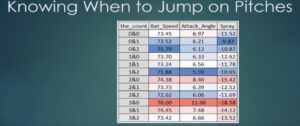
Other times, hard hit balls happen because of the HITTER’S execution and plan and approach — the hitter sitting on or anticipating a certain pitch speed or a certain pitch type in a specific count or situation, sometimes referred to as HUNTING PITCHES.

In the above PHOTO, the ball is over half way to home plate and Vlad’s PELVIS IS STILL LOADING and his bat is still vertical. In other words, THE LONGER YOU CAN CONTINUE to load & coil & move the middle, then THE LONGER YOU CAN GATHER INFORMATION by reading/recognizing the pitch and he “crushes” this ball.
Said another way, the greater your rate of force development and the shortest amount of time it takes to “execute your swing”, then the longer you can continue to load and coil and move the middle while gathering information on the incoming pitch.
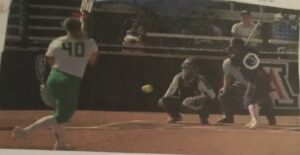
These hitters are having success because of the combination of great pelvis loading and tempo, great approach/pitch recognition, and extremely rapid rates of force development. It is a combination of multiple skills and the perfect execution by very talented athletes.
Approach basically comes down to EARLY PITCH RECOGNITION & making split second, quality decisions.
THE BEST HITTERS MAKE THE BEST MENTAL DETERMINATIONS
The greatest hitters have extraordinary visual skills and visual processing abilities combined with incredible athletic ability.
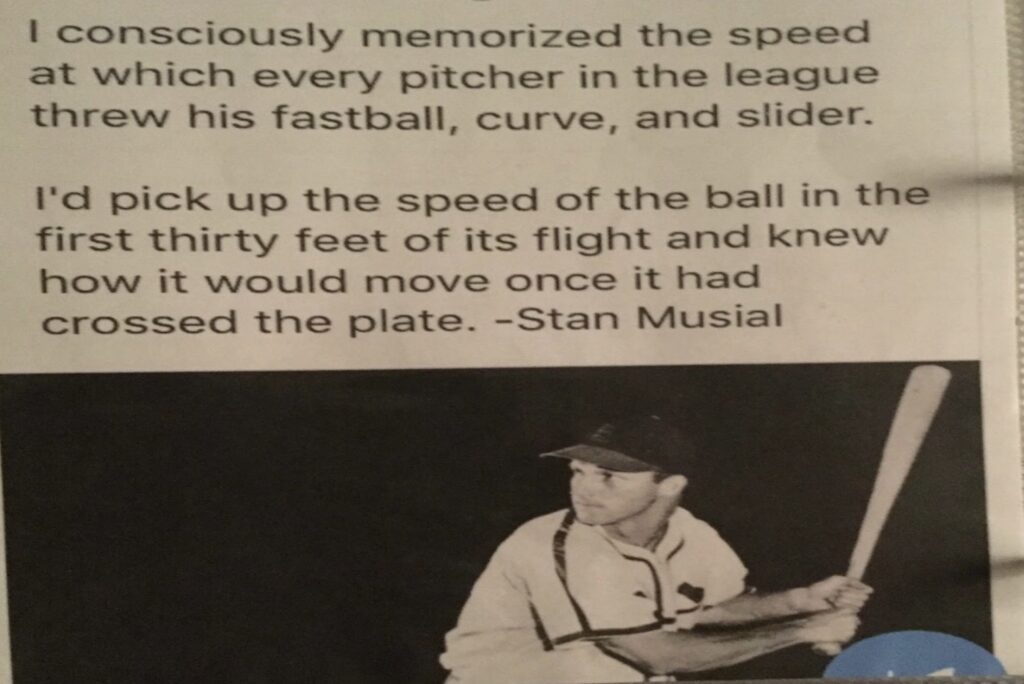
It is a “skill” to be able to:
- gather relevant visual data as fast as possible, then
- possess the capability to interpret the gathered data, then
- make the proper decision, then
- execute the swing with precision & power.
Elite hitters can pick up information and advanced cues from sources OTHER THAN JUST THE BALL; for instance, from the pitcher’s body position or even the pitcher’s body language.
Whereas, the novice, because of the lack of experiences, is just watching the ball and ball flight only, thus picking up NO OTHER CUES OR INFORMATION. So naturally, they struggle until they gain more experience and train to make decisions early and without having to “track the ball” and the ball only.
The best hitters subconsciously and intuitively have memorized and mapped in their heads every scenario and every different kind of pitch so they know the direction the incoming pitch is going and can anticipate and calculate the speed and trajectory QUICKLY WITH VERY LITTLE INFORMATION. They program their bodies to be in tempo and on time perfectly.
“Elite hitters make better mental determinations SYNCHED with more appropriate physical responses”. Mike Lotief.
The purpose of training or taking “batting practice” is to BUILD MORE GAME LIKE EXPERIENCES in order to create a MEMORY BANK & DATA BASE so our hitters can make better mental determinations and synch those decisions with the most appropriate physical response.
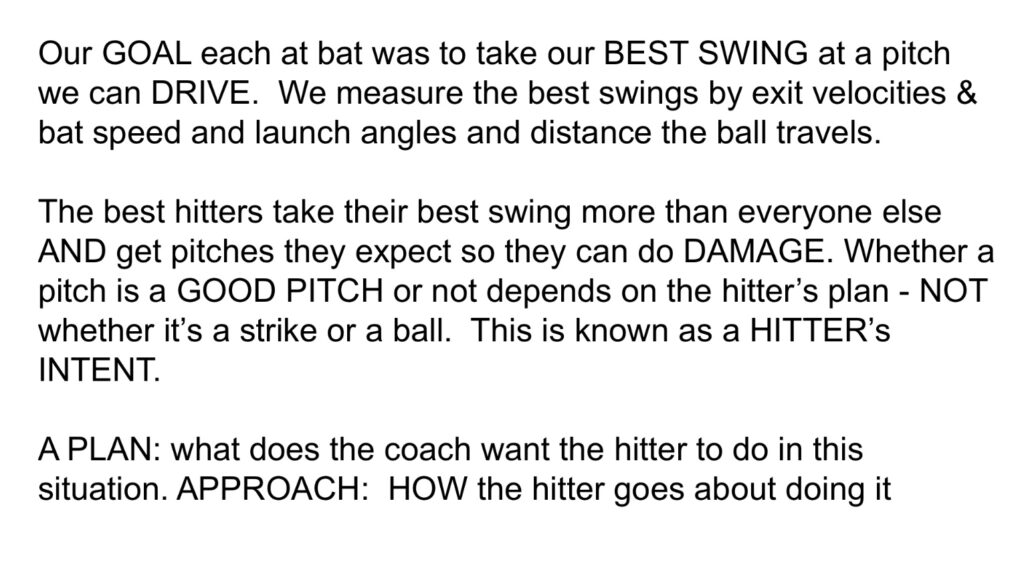
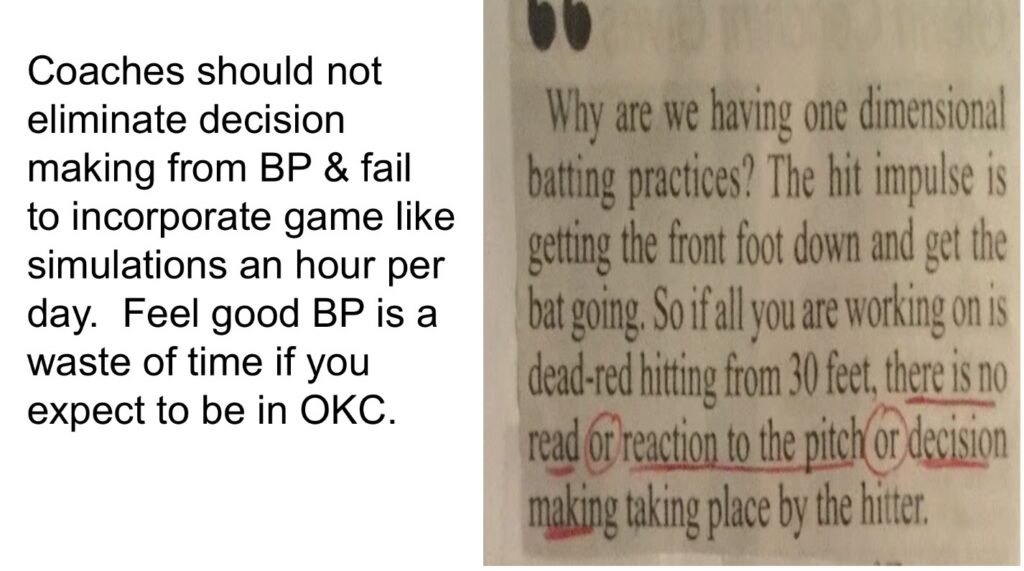
THE APPROPRIATE TRAINING ENVIRONMENT
The biggest thing high school and travel ball softball players have to learn when they get to college is recognizing the difference between the pitches “they like” &/or are accustomed to getting in high school (58 mph meatballs) versus the pitches that “they are going to get” now in college – velocity up & in, nasty change ups in hitters counts, curveballs that break vertically & horizontally.
Once the high school softball player gets in the college line-up, she may NEVER SEE that pitch she loved in high school & travel ball — so what’s the purpose on waiting for a pitch that you are most likely never going to get? Basically, it is about learning a whole new approach to at bats, and more than likely, creating a new data base and memory bank in your mind-body connection (sensorimotor system).
Learning the new data base and pitch recognition patterns is step one. Engraining the data base into the hitter’s memory takes thousands and thousands of repetitions. It takes lots of video and chalkboard discussions.
The hitter needs as many at bats that closely resemble and simulate what will happen in the game – what I call “WORLD SERIES AT BATS”.
That was a serious challenge for us at a mid-major; we had to prepare for a number 2 or 3 quality-type of arm in conference throwing “slow and slower” and nibbling on the outside part of the plate with number 5 & 6 quality type umpires. (Advantage: it helped us to develop our philosophy on opposite field power).
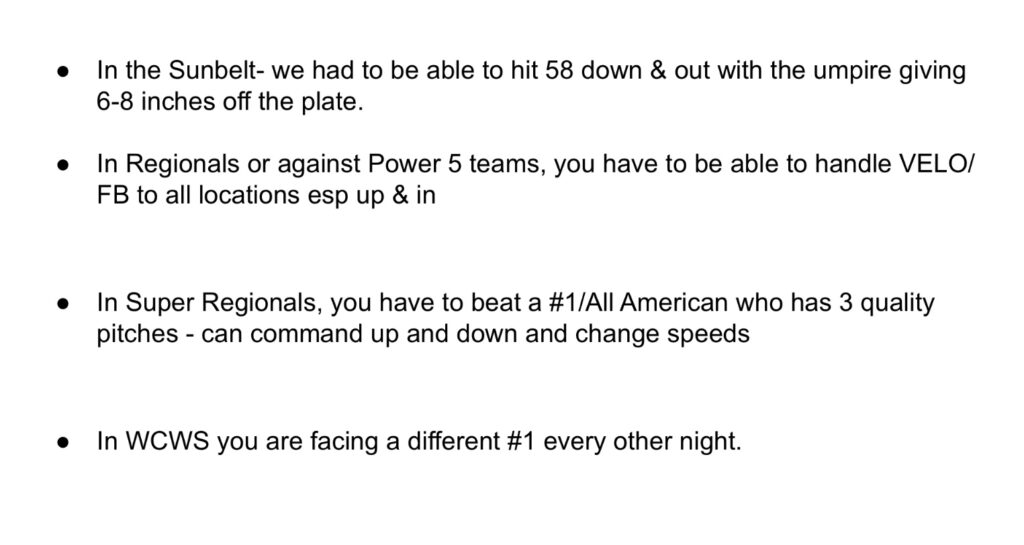
But we knew when we got to SUPERS and the WCWS that it was All-American pitchers who had it all —velocity up and in, great spin and secondary pitches, impeccable command and wipe out change-ups. We prepared for “WORLD SERIES AT BATS” EVERY DAY starting the first day of fall practice until the season ended for at least 45 minutes per practice and in every hitting discussion or hypothetical scenario that was presented.
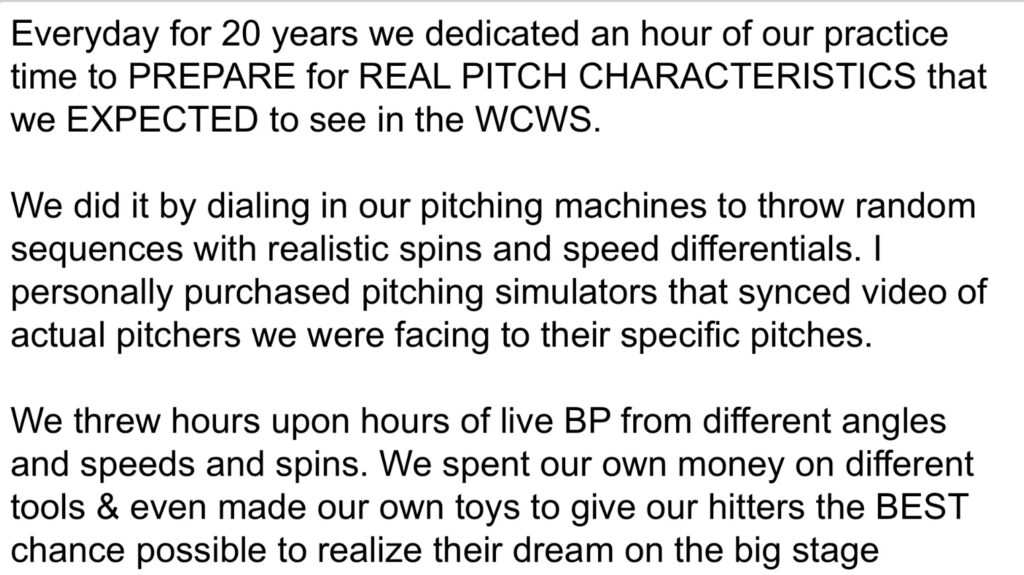
STEALING GRIPS IS NOT “PITCH TIPPING”
Let’s address the distinction between “pitch tipping” and “stealing grips”. There is a big distinction between pitch tipping or stealing a pitcher’s grip and yelling it out the hitter AND PITCH RECOGNITION.
I’ve literally seen coaches in college softball in the 3rd base coaches box peer into the pitcher’s glove & watch the pitcher’s palm or hand or fingers in her glove gripping the ball before her next pitch and then yelling out to the hitter what the pitch is. Hopefully, we all agree that is neither pitch tipping nor pitch recognition.
Pitchers are prone to develop tendencies in how they hold the ball, how they stand on the mound, and how they begin their deliveries and their mannerisms and body language can TIP OFF the hitter as to what pitch is about to come. So those non-verbal messages that the pitcher shows or TIPS to the hitter in his/her delivery can send cues as to what pitch the pitcher is about to throw. That’s TIPPING, and in the video below, David Ross talks about how he was “tipped off” by the pitcher before his home run in the World Series.
Softball spends a lot of time on the base coach peering into the glove of the pitcher to steal the grip and yell it out to the hitter as the pitcher gets to the top of the circle. I’m suggesting that there are other contextual patterns that pitcher’s fall into to, that if you are willing to put in the time watching game video/film and search hard enough through the data and statistics, you can find them.
Furthermore, pitch recognition is a SKILL that can be acquired by the hitter if the right training and learning environment is created and simulated and practiced. OVER & OVER & OVER AGAIN.
PURSUE EXCELLENCE & WIN THIS PITCH!
